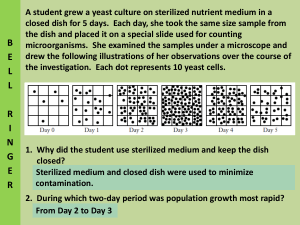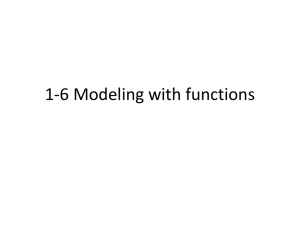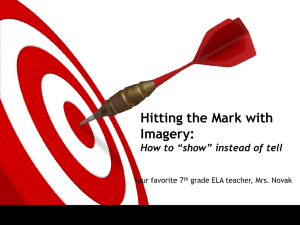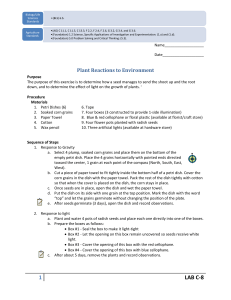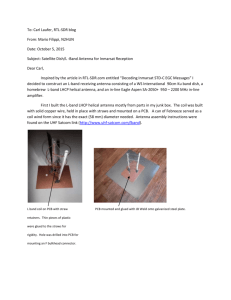display
advertisement
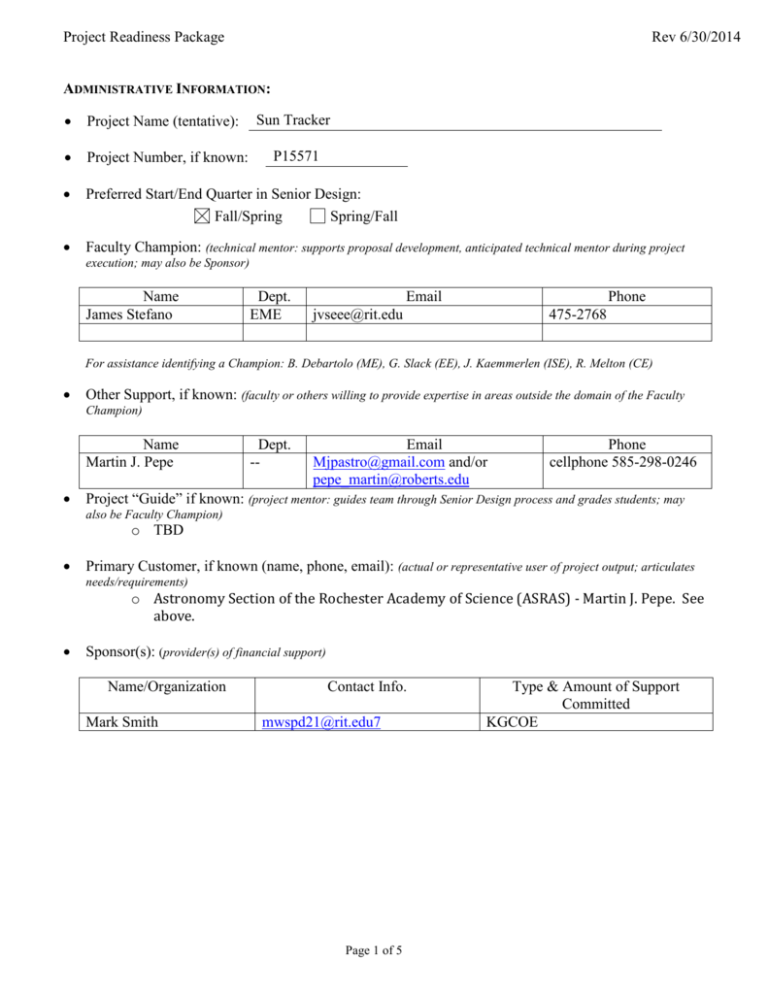
Project Readiness Package Rev 6/30/2014 ADMINISTRATIVE INFORMATION: Project Name (tentative): Project Number, if known: Preferred Start/End Quarter in Senior Design: Fall/Spring Spring/Fall Faculty Champion: (technical mentor: supports proposal development, anticipated technical mentor during project Sun Tracker P15571 execution; may also be Sponsor) Name James Stefano Dept. EME Email Phone jvseee@rit.edu 475-2768 For assistance identifying a Champion: B. Debartolo (ME), G. Slack (EE), J. Kaemmerlen (ISE), R. Melton (CE) Other Support, if known: (faculty or others willing to provide expertise in areas outside the domain of the Faculty Champion) Name Martin J. Pepe Dept. -- Email Mjpastro@gmail.com and/or pepe_martin@roberts.edu Phone cellphone 585-298-0246 Project “Guide” if known: (project mentor: guides team through Senior Design process and grades students; may also be Faculty Champion) o TBD Primary Customer, if known (name, phone, email): (actual or representative user of project output; articulates needs/requirements) o Astronomy Section of the Rochester Academy of Science (ASRAS) - Martin J. Pepe. See above. Sponsor(s): (provider(s) of financial support) Name/Organization Mark Smith Contact Info. mwspd21@rit.edu7 Page 1 of 5 Type & Amount of Support Committed KGCOE Project Readiness Package Rev 6/30/2014 PROJECT OVERVIEW: 2-3 paragraphs that provide a general description of the project – background, motivation, customers, problem you’re trying to solve, project objectives. BACKGROUND: The Callisto Solar Telescope consists of a 7 foot ‘C’ band satellite dish, modified Digital TV tuner running under PC control (Win XP) to study RF emissions from the Sun. Sunspots, Flares and Coronal Mass Ejections (CMEs) emit radio waves. Location in Rochester, NY (Ionia) fills a large ‘blind’ spot as there are no receivers in the Eastern USA or Canada. RF data files will be uploaded via (FTP) on the internet to a central server in Zurich, Switzerland, as part of a global (eCallisto) network. Tracking the Sun enables the system to have daylight sunrise to sunset operation. This work is sponsored by the Astronomy Section of the Rochester Academy of Science (ASRAS), (Martin Pepe, Radio AstronomyBoard of Directors). PROJECT: This project will control the aiming of the 7’ dish system toward the sun. This is accomplished through two existing linear actuators. One, for sunrise to sunset called Right Ascension (RA), and the second for seasonal elevation change called Declination (DEC). The need is to accurately control these actuators to track the Sun’s movement across the sky. Note: Investigating need for a wide-band antenna (45 MHz to sub 1 GHz). Or, purchase an off-the-shelf antenna. – Jim Stafano. If there is a need for antenna design, then this will add one or two EEs with antenna design experience. Note: For further details, slides & DVD video are available from Martin Pepe. DETAILED PROJECT DESCRIPTION: The goal of this section is provide enough detail for faculty to assess whether the proposed project scope and required skills are appropriate for 5th year engineering students working over two quarters. The sequence of the steps listed below may depend on your project, and the process is usually iterative, so feel free to customize. Emphasis is on the “whats” (qualitative and quantitative), not the “hows” (solutions), except for the section on “potential concepts,” which is necessary to assess the appropriateness of required skills and project scope. Not all of the information in this section may be shared with students. (Attach extra documentation as needed). Customer Needs and Objectives: Comprehensive list of what the customer/user wants or needs to be able to do in the “voice of the customer,” not in terms of how it might be done; desired attributes of the solution. o o o o o o o o o o Autonomously track Sun’s movement Real Time Clock (RTC) Power Supplies Dish tracking controls Integrate an existing PC application to translate RA and DEC to linear actuator positions Ensure positional accuracy (i.e. home positions and encoders) for both RA and DEC Locate home position on a daily bases or if control is lost Receiver enable signal (enable rf receiver when actuators are quiescent) Manual control for setup and reset operations Weather proof electronics Adjustable antenna to dish alignment On the current dish, Right Ascension (RA) movement which controls the east / west rotation and Declination (DEC) controls the seasonal elevation axis. RA and DEC tracking using linear actuators on the current dish has proved to be reliable but Team needs to consider, weigh and evaluate other designs. The current design is accomplished via a pair of these DC type Linear Actuators. Design and build two Linear Actuator mechanisms (LA, DEC) for movement and tracking of the existing 7’ dish. A 3’ LA is Page 2 of 5 Project Readiness Package Rev 6/30/2014 used for the (RA) Right Ascension (east / west rotation) with a movement of +/- 55 and a 2’ LA is for (DEC) Declination (elevation) axis. Potential for adding a third axis (as yet undefined) is to be evaluated. This design includes feedback from the actuator(s) internal, (existing) pulse encoder, and movement limit switches already integrated into the LA assembly. Design must be both open and short circuit proof, in case of mechanical binding or obstruction. A resettable mechanical ‘Center Home’ position is required, as well as a certain number of fixed memory positions. As an example, east/ west rise/set positions on ‘local’ horizon & zenith. See Radio Eyes sky simulation application. Think a Keystone shape axis changes for winter & summer rise/set times & positions. Variable Drive speed is to be investigated in order to achieve a 15 degree/ hour operation, required to account for Earth’s natural rotation speed (i.e.de-rotation). Small form factor PC or similar. This assembly is to receive ‘go to’ tracking & position data from the ‘Radio Eyes’ Sky program via ASCOM interface (running on a std. Win XP- PC), and a manual joystick (or switches) to manually position the dish for servicing the dish and initial setup, power management AC power management system to enable automatic recovery in case of intermittent power interruption(s), without any damage or loss of operation, after power returns (automatic Power Off/Power On). Links and references; Main Callisto website http://www.exp-astro.phys.ethz.ch/astro1/Users/cmonstei/instrument/callisto/index.htm eCallisto documentation http://www.expastro.phys.ethz.ch/astro1/Users/cmonstei/instrument/callisto/ecallisto/applidocs.htm Typical Data (from existing EU sites) http://soleil.i4ds.ch/solarradio/ ASRAS - Radio Telescope section http://www.rochesterastronomy.org/Activities/RadioAstronomy.aspx Constraints: External factors that, in some way, limit the selection of solution alternatives. They are usually imposed on the design and are not directly related to the functional objectives of the system but apply across the system (eg. cost and schedule constraints). Constraints are often included in the specifications list but they often violate the abstractness property by specifying “how”. Dish is located in Ionia, New York and the dish-antenna system is mounted in concrete. Therefore, this Team will not be able to physically install on the 7’ dish at RIT for build and testing. Team will need to periodically perform on-site tryouts during the build and debug phases for proper fit and function. Team may need to define a “test bench” approach around this problem. It is advised that the team perform an on-site visit at start of project. Perhaps come back with photographs and various physical measurements. Determine if motors interfere with RF measurements. If yes, then RF measurements need to be halted during dish movement but not long enough to loss RF data. Page 3 of 5 Project Readiness Package Project Deliverables: Expected output, what will be “delivered” – be as specific and thorough as possible. o o o o Working system. Wiki for the project Operation Manual Software Manual for Software Libraries developed. Budget Estimate: Major cost items anticipated. Rev 6/30/2014 $500. Intellectual Property (IP) considerations: Describe any IP concerns or limitations associated with the project. Is there patent potential? Will confidentiality of any data or information be required? None. Other Information: Describe potential benefits and liabilities, known project risks, etc. Benchmark existing system. Field visit to location. Continuation Project Information, if appropriate: Include prior project(s) information, and how prior project(s) relate to the proposed project. STUDENT STAFFING: Skills Checklist: Complete the “PRPChecklist” document and include with your submission. o ATTACHED Anticipated Staffing Levels by Discipline: Discipline EE How Many? 3 (4) * 2 ME CE ISE 1 (0) Anticipated Skills Needed (concise descriptions) Design of control systems, sensor interface, power. Manual and auto modes. Linear Actuator to dish angular translation, movement and mounting of LA, antenna mount, unattended reliability, weather proof design, internal mounting of components in enclosure, preliminary site research, testing,. Computational units and interfaces, Software libraries. Integrate existing Application Software. 0 Other * = TBD: This does not include Antenna design. This is being evaluated. Page 4 of 5 Project Readiness Package Rev 6/30/2014 OTHER RESOURCES ANTICIPATED: Describe resources needed to support successful development, implementation, and utilization of the project. This could include specific faculty expertise, laboratory space and equipment, outside services, customer facilities, etc. Indicate if resources are available, to your knowledge. Category Faculty Resource Available? Description James Stefano George Slack Environment 09-3000 Senior Design Lab Multidisciplinary Senior Design Laboratory Equipment Materials Prepared by: Martin Pepe, Jim Stefano, George Slack Page 5 of 5 Date: 7/2/2014



